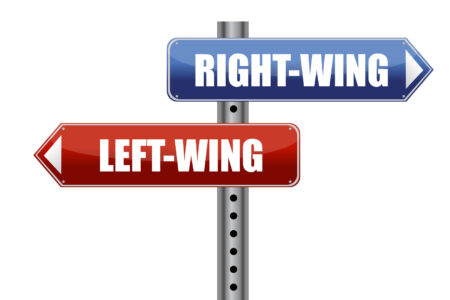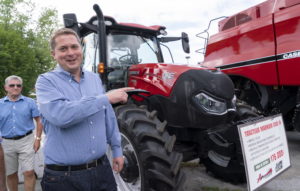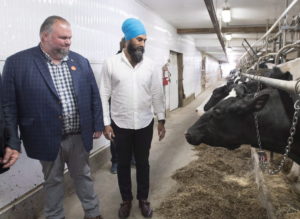
With Canada’s 43rd federal election campaign about to unfold, political parties are fine-tuning their messaging aimed at the one-in-five Canadians living in rural areas. It is a familiar narrative: rural Canada matters, rural Canadians deserve better and we (fill in the party name) have a strategy to help. It begins by being empathetic, solicitous and concerned while conceding past performance has not been good enough.
Reaching voters thinly spread across large areas with often-poor internet connectivity can be a daunting and expensive task. But rural voters represent a powerful electoral force. When the voter base in a constituency is just a fraction the size of densely populated urban ridings, winning over an individual rural voter can carry more election-day weight than garnering the support of three or four urban voters.
Like the predictable political promises and enhanced attention rural Canadians can expect, mainstream media attention to rural issues and campaigns also will be more visible than usual, albeit superficial. Reporters will be there to report on the voter reaction and rural interest when leaders’ tours venture into the hinterland. Occasionally, reporters or television cameras will drop by to get some quotes about the impact on farmers’ incomes of the loss of Chinese markets or to analyze the impact on rural-based businesses of spotty cell and internet service and infrastructure gaps.

However, if election coverage in 2019 follows the well-established historic pattern, rural issues and analysis will receive scant detailed attention. Media planners are urban-based and most reporters received their education and experience in urban areas. The nuances of rural issues can be complicated and counter-intuitive to a city-based journalist. Besides, national election outcomes rarely are decided in rural Canada, and a commitment to spend limited resources on expensive, in-depth rural issues research is a hard sell.
For rural voters, the scant coverage of their issues means their infrastructure, income or market access concerns will lack the broader political attention needed to create pressure on the next government to act. For the Canadian body politic, the lack of rural issues coverage will be a missed opportunity to illustrate the similarities in values and priorities between what often are rural and urban solitudes.
Rural interests are different
With electioneering machinery and political messaging ramped up this summer, rural leaders and activists like Ron Bonnett can be excused for thinking they have heard it all before. The recently retired Canadian Federation of Agriculture president has heard commitments to fill rural program, infrastructure and service gaps and promises by politicians to maintain a focus on the rural issues requiring solutions.
“I don’t question their sincerity or intentions in making promises,” he said during a break from summer haying at his northwest Ontario beef farm. “But I do believe that there often is a view that providing services and programs and infrastructure for rural and urban are essentially the same process, but they are not. It often leaves a gap between the intentions and the result.”
Veteran observers and players inhabiting the extensive swathes of territory between the built-up centers observe that the political sensitivities and vulnerabilities of rural interests often are under-estimated by urban-centered politicians and reporters who cover them. Meanwhile, the challenges and costs of investing in infrastructure and services for low-density populations spread over vast distances add complexities that do not exist when programs are delivered to concentrated urban areas.
“The reality is that the per capita costs of providing services in rural areas is far higher than providing comparable services in urban areas and the political payback is less because there are fewer people benefiting,” argues veteran Prairie New Democratic Party player Howard Leeson, who spoke to me from his farm in the Cottonwoood Valley area of Saskatchewan northeast of Regina.
“For example, rural communication and Internet service is far more costly and less developed than in the cities, and I think many politicians don’t truly grasp that difference. Promising it does not mean it will happen.”

Thin journalistic resources
Former agriculture minister and four-term rural Ontario Liberal MP Andy Mitchell, elected four times in Parry Sound — Muskoka riding, credits urban media and reporters for occasionally dropping in to gauge the local campaign, talk to some voters about their issues and profile the candidates.
But, still, in his day the bread-and-butter rural election coverage came from local broadcast reporters and weekly newspapers.
“The local community paper, although an increasingly rare breed, is the best vehicle for covering local issues, and people read it cover to cover,” he told me. “Urban outlets try, but they quickly find rural issues are complicated, demands and needs are different than in urban ridings and reporters don’t have the background.”
But even rural media voices are dwindling.
A factor in the limitations of rural election coverage is the steady erosion of rural media outlets and independent voices. As in urban Canada, the number of rural media outlets is falling, centralized ownership is increasing and newsroom budgets are tightening. Fewer independent rural media voices mean fewer outlets where local and community issues can be aired, fewer editorial pages where the pros and cons of important local debates can be examined, and fewer public-information platforms where local politicians can hear what is on constituents’ minds. In rural areas where reliable internet access is available, social media platforms can be a two-way information rural road. But many rural politicians insist they are not a substitute for a media outlet with roots in the community and a commitment to keep their readers informed and educated about local political issues.
I am a relic of a different time. Back in the day — during more than three decades of national coverage from a perch in the Parliamentary Press Gallery as national correspondent for the Saskatoon-based agricultural newspaper The Western Producer — federal elections were a much-anticipated opportunity to re-acquaint myself with the rural nooks and crannies of this vast country.
Between elections, assignments mainly revolved around covering the details of agricultural policy planning and debate in Ottawa and around the country, federal-provincial negotiations and industry meetings, food industry lobby efforts and priorities.
For regular spice in the journalistic diet, there was travel abroad to report on international trade negotiations, agriculture ministers’ meetings and conditions in Canada’s foreign markets and competitor countries.
But come election time, the assignment was to travel across Canada from far east to far west, investigating simmering rural election issues, talking to candidates and voters, assessing political party promises and strategies for rural voters and trying to understand the political needs and dreams of the millions of rural voters whose priorities often were crowded out by coverage of the issues and races in the voter-rich urban areas of the nation. Our rural readers had their voice.
Alas, The Western Producer closed its one-of-a-kind Ottawa bureau in 2014, when I retired. Without a successor, a unique national rural news coverage and commentary perspective was lost. While some urban-based media organizations have experimented with the idea of hiring a “food” or “rural affairs” specialist, the idea generally has fizzled when a commitment to sustained funding and news space has not materialized. Canadian political debate overall has suffered as a result of this gap in coverage, as well as the recognition that both rural and urban areas share aspirations and strengths, contributing economically, culturally and intellectually to the nation.
This article is part of The media and Canadian elections special feature.
Photo: Justin Trudeau puts his son on a tractor at the International Plowing Match and Rural Expo in Walton, Ont., on Friday, September 22, 2017. THE CANADIAN PRESS/Chris Donovan
Do you have something to say about the article you just read? Be part of the Policy Options discussion, and send in your own submission. Here is a link on how to do it. | Souhaitez-vous réagir à cet article ? Joignez-vous aux débats d’Options politiques et soumettez-nous votre texte en suivant ces directives.






